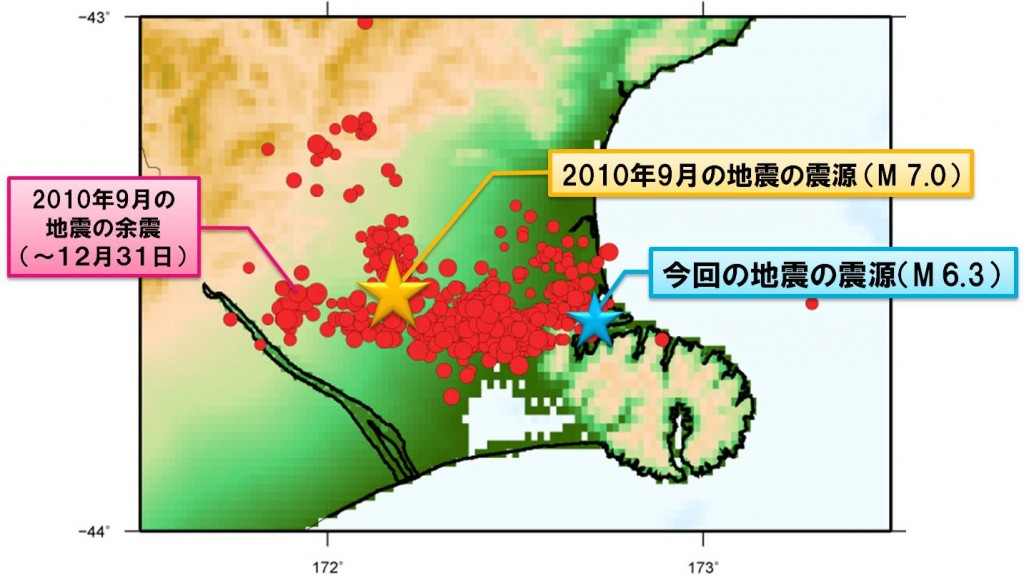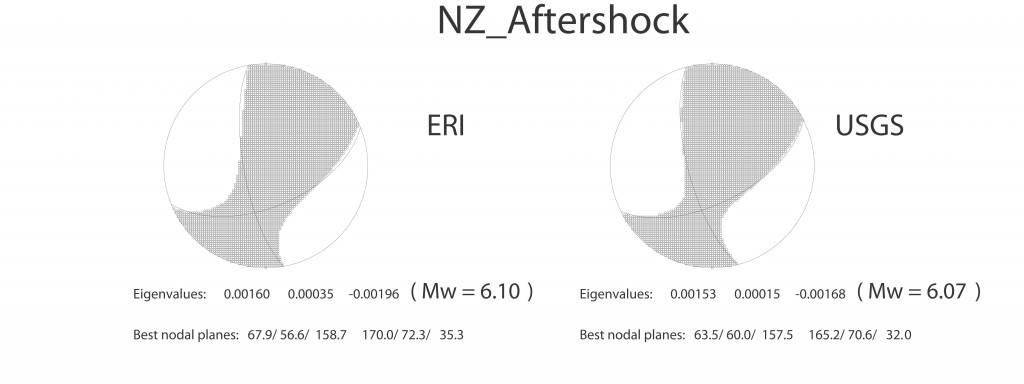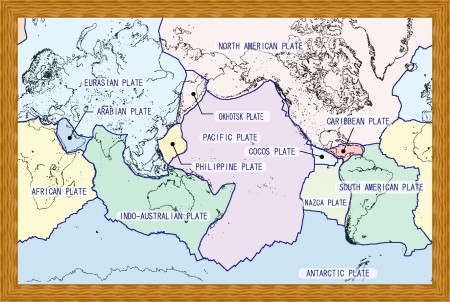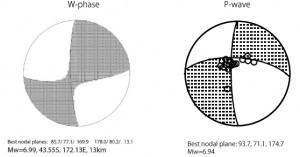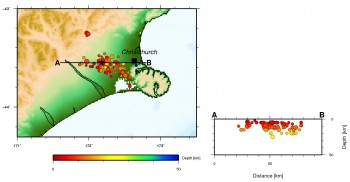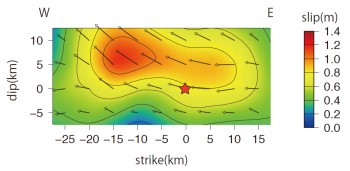Launched: September 7th, 2010
At 1:35am (Japan time. Local time 4:35am) September 4th, a shallow inland earthquake of magnitude 7.0 occurred near Christchurch, NZ (by USGS). According to CNN, there are no deaths, 2 severely injured and 100 slightly injured (as of September 5th, 1:30 Japan time ).
Information on this earthquake will be updated on this website. (Outreach and Public Relations Office)
Earthquake on February 21st 2011
[ Basic Information ] (compiled from USGS)
- date and time : 12:51 pm, February 21st, 2011 (Japan time. Local time, 08:51am)
- location of hypocenter: 43.60S, 172.71E, 5 km deep
- magnitude: 6.3
- type of earthquake: right-lateral fault with thrust component
- related plates: Australian plate, Pacific plate
- l major cities in the area: Christchurch,
- damage to people: at least 75 deaths (February 23rd, 1:30pm, Japan time)
[Aftershock Distribution of September 2010 EQ and the hypocenter of the 2011 EQ]
The epicenter of the 2010 September earthquake is shown in yellow star. The red dots present the aftershock distribution that occurred from 4th September till 31st December 2010. The blue star presents the epicenter of the earthquake this time.
[Focal Mechanism derived by W-phase and P-wave ]
Following is the focal mechanism derived by W-phase data recorded worldwide, using Kanamori and Rivera (2008) method. Considering the above aftershock distribution, and by the left figure below, this focal mechanism can be assumed that it consists from both right-lateral strike-slip with thrust component. The right figure below is also the focal mechanism derived by W-phase, done by USGS, and is indicating the same.
Earthquake on September 4th 2010
[ Basic Information ] (compiled from USGS, GNS Science and CNN)
- date and time of earthquake : 1:35am, September 4th, 2010 (Japan time. Local time, 4:35am)
- location of hypocenter: 43.55S, 172.18E, 10km deep
- magnitude: Mw7.0
- type of earthquake: right-lateral strike-slip
- related plates: Australian plate, Pacific plate
- major cities in the area: Christchurch, 44km east of hypocenter
- damage to people: 0 deaths, 2 severly injured, 100 slightly injured (September 5th, 1:30pm, Japan time)
[ Tectonic Background ]
New Zealand has a very complex tectonic background. North Island and the northern part of South Island is on the Australian plate, and the central/southern part of South Island is on the Pacific plate. At North Island, the Pacific plate subducts from the east to the west beneath the Australian plate at approximately 8cm/yr, whereas at southern South Island, the Australian plate subducts from west to east beneath the Pacific plate. According to this circumstance, there is an on-going strike-slip fault at central South Island, which locates in-between.
This earthquake on September 4th is assumed to have a right-lateral strike-slip fault mechanism affected by the tectonics in central South Island.
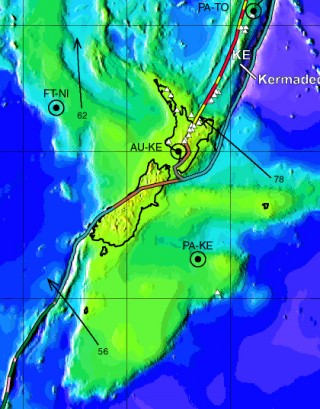
Plate tectonics around NZ. from PB2002 model (http://peterbird.name/publications/2003_PB2002/2003_PB2002.htm)
[Focal Mechanism]
Following is the focal mechanism derived by W-phase and P-wave data recorded worldwide, using Kanamori and Rivera (2008), and Kikuchi and Kanamori (1991) methods, respectively. analysis of the from the earthquake wave data observed worldwide with this earthquake. With the result (Fig.1) and the aftershock location (Fig.2) determined by GNS Science, this earthquake can be assumed that it is a Mw7.0 right-lateral strike-slip earthquake that occurred in the east-west direction almost perpendicular to the fault surface. Here we have obtainted the fault model using the fault mechanism by W-phase analysis, and with it, have done another inversion of the P-wave data. Looking at the slip distribution (Fig.3), the fault rupture proceeds east from the rupture starting point ( red star in Fig.3 ), and there may be a possibility that it did not cause an enormous shake at Christchurch located to the east. ( Yokota, Yun, Kawazoe, Oki and Koketsu)
[ Links ]
- USGS: “Magnitude 7.0 – SOUTH ISLAND OF NEW ZEALAND“
- GNS Science: “shallow earthquakes within the last 60 days”(余震分布)
- GNS Sciense: New Zealand Active Faults Database
